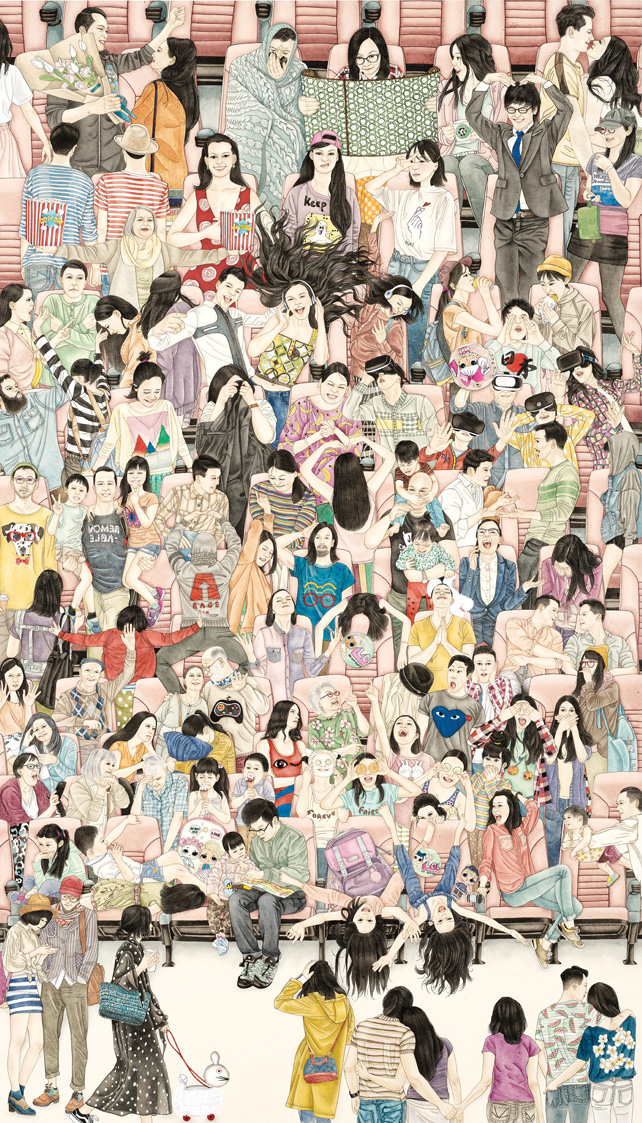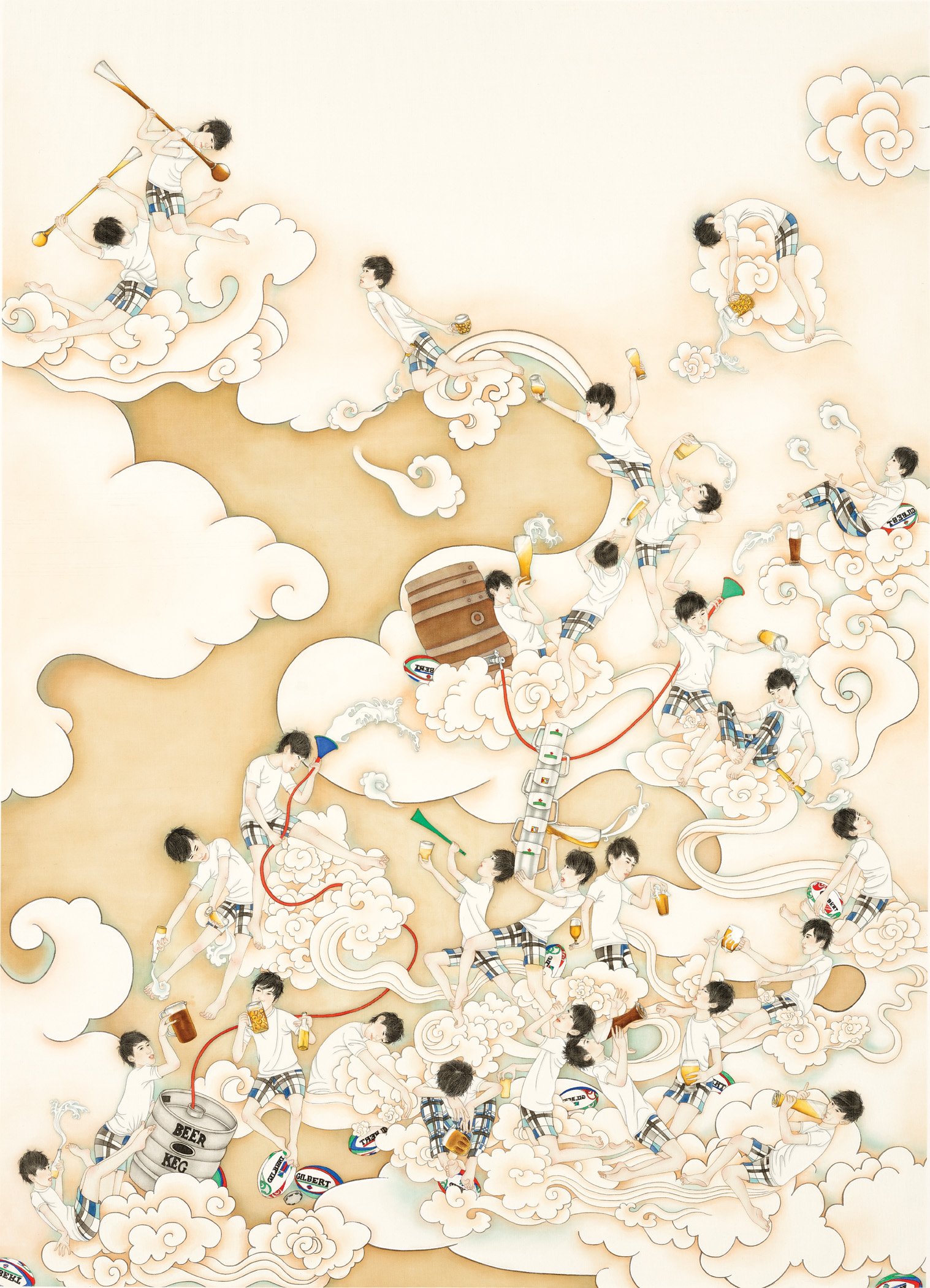梁 麗 雯
Jess Leung Lai-man (lives and works in Hong Kong) graduated from the Academy of Visual Arts at Hong Kong Baptist University (HKBU) in 2015 and she received additional training at the HKU School of Professional and Continuing Education (HKU SPACE). She uses Chinese gongbi painting to depict Hong Kong cityscapes, revealing the touch of hidden anxiety and repression embedded within urban life and sociocultural transformation.
Leung has participated in exhibitions such as “Letting Go” (HKBU & 1a Space, 2021), Ink Global (2017, 2021), Ink Asia (2015), and the Cliftons Art Prize exhibition (2015). She has received several awards, and her works are held by China CITIC Bank International Limited (CNCBI) and private collections.
梁麗雯,香港居住及工作,2015年畢業於香港浸會大學視覺藝術院,並取得一級榮譽學位,及後於香港大學專業進修學院修讀中國書畫研究文憑及中國山水畫文憑課程。梁氏擅長以中國工筆畫法描繪人物的城市世相,觀照日常,揭示城市生活和社會文化變遷隱匿的焦慮和壓抑。
梁氏作品曾展出於「再見再見」(1a空間及香港浸會大學視覺藝術院,2021)、「全球水墨畫大展」(2017、2021)、「水墨藝博」(2015)及Cliftons 藝術獎(2015)等。曾多次獲獎,其作品獲中信銀行和私人收藏。
Artist’s Statement
Gongbi (fine-brush) painting is magnificent yet refined, with rich layers of wash and vivid brushwork. This kind of painting always inspires concentrated observation. I am drawn to gongbi painting, particularly figure painting, because it allows me to depict the minute beauty of figures in urban settings and helps me to appreciate the ways of the city.
After flourishing in the Tang and Song dynasties, gongbi figure painting experienced a rupture, so it is difficult to directly apply ancient techniques or that expressiveness of line to the contemporary context. Every kind of art has its own history, and I think that, while gongbi painting is overlooked, it is still an extremely important Chinese art. By combining traditional gongbi painting techniques with contemporary life and real people, I hope to give gongbi painting a modern sensibility and record life today. The three works exhibited here feature Hong Kong cityscapes, depicting the constraining patterns of urban life, society, and culture.
Black Box Wandering II is an extension of my early realist figures. Taking a theatre as its setting, a series of stories or moments are placed into the seats, offering a glimpse into the life of the city. Party Animal and Tipsy Pleasure draw from the Hong Kong Rugby Sevens. Party Animal depicts the frenetic pace of Hong Kongers working hard and playing hard. With the pandemic disruptions of the last two years, our lives have become very individualised. Established habits and lifestyles, as well as the people and things that we had previously taken for granted, are no longer certain; we’re at a party, but we’re still not happy. Tipsy Pleasure shows people in a slightly drunken state. They sway to the rhythm, experiencing a blend of happiness and loneliness; they are solitary yet free. With sad smiles, they dance in the sky, free as the clouds. Pressure building over a long period needs to be released, a reflection of an inner yearning within those who have lost their zest for life.
藝術家自述
工筆畫華麗細膩、渲染層次豐富、追求用筆生動,作品令人凝神靜觀。我深被工筆畫吸引,尤其工筆人物畫,它讓我可以在創作時描繪出都市人物的纖毫之美,帶我賞尋城市世相。
工筆人物經歷唐宋的繁榮後發展出現斷層,所以古人的技法或線條的表現方式,難以直接用在當代的語境中。每種藝術都有他獨有的歷史性,而我覺得工筆被忽略了,它是極為重要的中國藝術。我希望藉着我的作品在傳統工筆畫技法上,加入當代生活與現世人物結合,把工筆畫帶來現代感,記錄生活。是次展出三張作品以香港的城市景觀為題材,描繪壓抑的城市生活和社會文化形態。
《匣子雲遊II》是我早期寫實人物的延續,以戲院為場景,一個個故事瞬間在座位中穿插着,窺探城市世相。《派對動物》和《醉好時光》都是以香港七人欖球為創作藍本。其中《派對動物》描繪了香港人努力工作外、又認真耍玩的瘋狂生活態度,在突如其來已擾攘了兩年的疫情下,人們的生活變得個人化,固有的習慣和生活模式,跟過去被認為是理所當然的人和事已經不再確定,身處派對但不快樂。《醉好時光》帶出人在微醺下的狀態,他們在節奏中搖曳,快樂與寂寞混合,有點寂寞卻又自由。 帶著悲傷的眼睛微笑, 在天空中舞動,像雲一樣自由。積累以久的壓力需要釋放,是對生活失去熱忱的人,內心渴望的一種投射。


